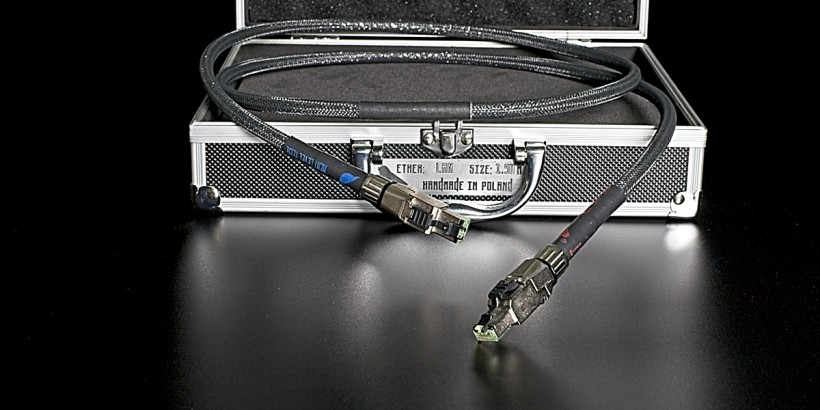Until recently Pass Labs XP-12 was the manufacturer’s only standalone preamplifier I’d sampled. Fast forward four years and its larger costlier sibling – Pass Labs XP-22 – finally showed up. Enjoy!
Relevant dinosaur
Pass Labs’ track record here at HifiKnights dates back to June 2017, when the material about the company’s compact HPA-1 headfi deck went live. In April 2019 I reviewed Pass Labs XP-12 preamp, which was also used inside Pass Labs INT-25 integrated machine that had its own publication in September 2020. Strip the latter from the former and Pass Labs XA-25 stereo power amp is the result. That was covered in March 2023. These four encounters were more than enough to understand the Pass Labs credo. Each review separated by roughly two years also implies buttoned up planning that’s far from accidental. These long intervals are necessary. As the company’s spokesman Desmond Harrington explained, paying customers come first, which is a very reasonable policy to have. Press people simply have to patiently stand in line for their turn. When the time is right, we get our chance. Interestingly, this year had in store two such opportunities for Srajan and me. If happiness comes in doubles, Lady Luck was on our side. It’s a tradition of sorts that all Pass Labs/Firstwatt assignments are our conjoined efforts. Srajan’s introductory lay of the land is followed by my input, then the man’s own impressions and his final words. That’s why today’s XP-22 loaner was first sent my way and forwarded from my place to Ireland several weeks later. Needless to say, getting such jobs done in timely manner is the top priority that puts teamwork on the pedestal. It also makes any talks about firsties rather silly. Besides hey, friends share. More importantly, prior to the XP-22’s arrival neither of us had sampled any other dual-box Pass affair. This $9’975 model sits one step above its entry-level single-chassis XP-12 sibling, but the manufacturer’s preamp roster doesn’t end there. Triple-box XP-32 wants $18’375, while XS Preamp priced at $38’000 and packed into two larger enclosures occupies the very top. The XP-22’s positioning roughly in the middle of that lineup doesn’t take away anything from its upper-echelon status, however. Spread across two boxes, expensive and designed by none other than the company’s small-signal guru Wayne Colburn, this is a serious design no less. These are also the reasons why I think of it as the manufacturer’s third best rather than a mid-tiered type.
It’s a tradition of sorts that all Pass Labs/Firstwatt assignments are our conjoined efforts. Srajan’s introductory lay of the land is followed by my input, then the man’s own impressions and his final words. That’s why today’s XP-22 loaner was first sent my way and forwarded from my place to Ireland several weeks later. Needless to say, getting such jobs done in timely manner is the top priority that puts teamwork on the pedestal. It also makes any talks about firsties rather silly. Besides hey, friends share. More importantly, prior to the XP-22’s arrival neither of us had sampled any other dual-box Pass affair. This $9’975 model sits one step above its entry-level single-chassis XP-12 sibling, but the manufacturer’s preamp roster doesn’t end there. Triple-box XP-32 wants $18’375, while XS Preamp priced at $38’000 and packed into two larger enclosures occupies the very top. The XP-22’s positioning roughly in the middle of that lineup doesn’t take away anything from its upper-echelon status, however. Spread across two boxes, expensive and designed by none other than the company’s small-signal guru Wayne Colburn, this is a serious design no less. These are also the reasons why I think of it as the manufacturer’s third best rather than a mid-tiered type.
The main difference between Pass Labs preamps narrows down to their noise floor; the lower it is, the higher the SNR and dynamics. These two factors are the main contributors to unlocking audible performance tiers and each extra step demands more resources; parts, R&D time and assembly hours. Team Pass isn’t secretive about means mandatory to make these leaps. The better their products are, the more internal space they need, so the more money you spend, the more enclosures you get. It’s all there at the Pass Labs website and quite self-explanatory for enthusiasts who already know what a good preamp does. Others won’t even bother. A DAC with variable outputs or in-app digital attenuation do the job just fine for them. The question to ask here is this: when and to whom ‘just fine’ is not enough? If you couldn’t care less about where and how volume control is executed in your setup, a standalone preamp isn’t for you. Meanwhile, those who care already know that the role of such products goes beyond this one basic utility. Preamps improve comms between sources and power amps and leave their own often large fingerprint on a system’s sound. That may possibly land a major performance hike, or a sideway move that our ears may fancy more. I’ve been there. Several years ago my previous DAC’s in-built posh resistor ladder attenuator was the best thing ever, until one day it got beaten to a bloody pulp by one reasonably priced external active preamp. Before that had happened I simply assumed that in audio simpler always meant better. More specifically, I considered such hardware in-between a DAC with regulated outs and power amp as an obstacle that makes the signal path longer and effectively inferior sound. The reality had it otherwise, live and learn. Pass Labs XP-22 is for those listeners who had transitioned from theorizing and assuming to knowing and understanding. And yes, ‘just fine’ doesn’t quite cut it for that kind of audience.
If you couldn’t care less about where and how volume control is executed in your setup, a standalone preamp isn’t for you. Meanwhile, those who care already know that the role of such products goes beyond this one basic utility. Preamps improve comms between sources and power amps and leave their own often large fingerprint on a system’s sound. That may possibly land a major performance hike, or a sideway move that our ears may fancy more. I’ve been there. Several years ago my previous DAC’s in-built posh resistor ladder attenuator was the best thing ever, until one day it got beaten to a bloody pulp by one reasonably priced external active preamp. Before that had happened I simply assumed that in audio simpler always meant better. More specifically, I considered such hardware in-between a DAC with regulated outs and power amp as an obstacle that makes the signal path longer and effectively inferior sound. The reality had it otherwise, live and learn. Pass Labs XP-22 is for those listeners who had transitioned from theorizing and assuming to knowing and understanding. And yes, ‘just fine’ doesn’t quite cut it for that kind of audience.
A massive reinforced cardboard delivered to my address was the largest from Pass Labs I’ve seen yet. Two separate boxes found there had multiple foamy liners to separately lock into place the key component and its alike-sized power supply box, both inside thick foil bags. Sundry accessories included a manual, spare fuse, two AAA batteries, QC leaflet, rugged 10-pole umbilical twist-lock cord and handy quality aluminium RC with all the buttons to fully operate the product from afar. This bulletproof remote is the manufacturer’s standard also used in i.e. XP-12 and INT-25 models. Each of the two Pass Labs XP-22 enclosures measures 43 x 10 x 32cm, so stacked they’re about 25cm high and their total mass is just above 18kg. This twin lot is manageable, but not a trifle to carry and move around. On-site specs list 9.3/6dB gain on balanced/single-ended outputs, 22kΩ input impedance, 25/50Ω output impedance on RCA/XLRs, cross talk >100dB, SNR <0.001 (@1V, 1kHz), 10Hz – 20 kHz frequency response within +/-0.05dB and power draw of 40W.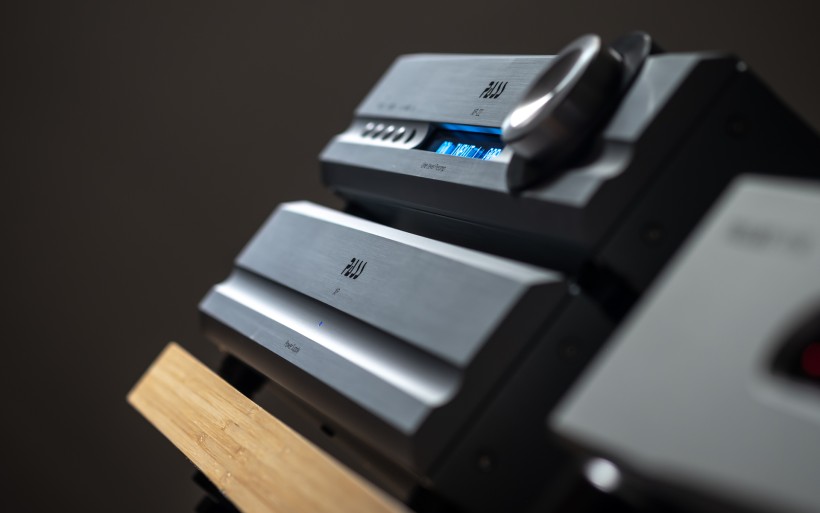 One short glimpse at Pass Labs XP-22 is all it takes to see it as the company’s XP-12 atop one extra enclosure. Their alike frames with thick milled foreheads trimmed on top and bottom make these models visually identical lookers. Modest utilitarian dress code reigns supreme all across the Pass Labs roster. Practicality, ruggedness, top assembly, simplicity and long-term reliability win over flamboyance, bling, flash and multitasking. That said, the XP-22 is an active purist analog preamp designed to excel at one specific job and that’s it. Neither it streams nor converts digital to analog or accommodates headphones, so in that sense it’s a dinosaur. Enthusiasts who don’t pursue integration and any modern utilities will find this specimen particularly appealing and very much relevant because of its single-purpose use. Such shoppers tend to spend their money at well-established old-school audio houses specialized in just several purist component types. Pass Labs fits that profile to a tee.
One short glimpse at Pass Labs XP-22 is all it takes to see it as the company’s XP-12 atop one extra enclosure. Their alike frames with thick milled foreheads trimmed on top and bottom make these models visually identical lookers. Modest utilitarian dress code reigns supreme all across the Pass Labs roster. Practicality, ruggedness, top assembly, simplicity and long-term reliability win over flamboyance, bling, flash and multitasking. That said, the XP-22 is an active purist analog preamp designed to excel at one specific job and that’s it. Neither it streams nor converts digital to analog or accommodates headphones, so in that sense it’s a dinosaur. Enthusiasts who don’t pursue integration and any modern utilities will find this specimen particularly appealing and very much relevant because of its single-purpose use. Such shoppers tend to spend their money at well-established old-school audio houses specialized in just several purist component types. Pass Labs fits that profile to a tee.
A short concaved area on the XP-22’s forehead houses four pushbuttons; ‘mute’ with a LED that goes blue if engaged, ‘mode’ for dimming (either on or off) the nearby fluorescent screen and two input selectors. Further to the right there’s the IR eye, black-on-blue display readable from afar and aluminum volume knob (100 x 1dB steps) inside a thick black machined ring. This endlessly rotating cylinder operates very smoothly and has spot on friction during movement, most likely due to a thin felt insert attached either to its underside or the enclosure. Four aluminium pucks with felt pads support the underbelly. The rear is busy with the ‘aviation-grade’ locking input for the PSU box, trigger socket, three outputs (2 x RCA and 1 x XLR), full tape I/O on RCAs and five inputs (3 x RCA and 2 x XLR). The fifth input usable as unity buffer (0dB gain at max. vol. level) for home theater mode is accessible only via RC. The power supply unit is the preamp’s visual twin minus its buttons, display and volume knob. A single LED in the middle of its front panel goes blue upon powering on the product, which is the only feature an external power supply really needs. The PSU’s business end features an IEC inlet with the main on/off rocker and self-replaceable fuse, while a 10-pin outlet closer to the center connects it with the preamp via the umbilical cord included in the set.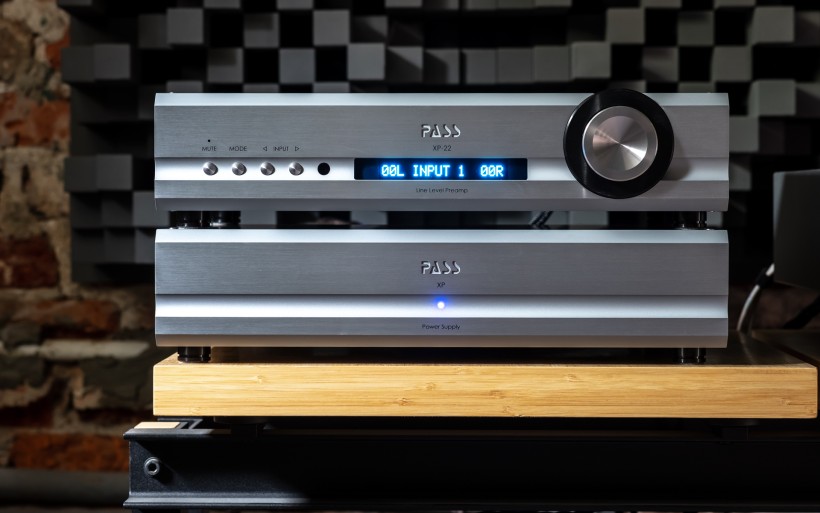 One-box designs house delicate electronics just next to power supplies. The closeness of these bits generates noise, so separating them is the well-known way of lowering it and effectively improving performance. Some manufacturers offer optional external PSUs as non-mandatory upgrades for their core goods. Here i.e. Lumin and Brinkmann come to mind. Pass Labs products however are designed to work at their highest gear from the get-go and XP-22 is no exception. If after listening to this one you still luster for better sound, XP-32 is the next move up in the same lineup and XS Preamp after that, which is simple and comforting in a way. Moving on, the loaner’s power supply unit is a dual-mono type comprised of twin double-shielded Avel Lindberg trafos, discreet rectification and voltage regulation stages and 8x caps of 40’000µF/50V filtering capacitance in total. The preamp box is a class A design based on the company’s patented Super-Symmetry topology. NOS Toshiba A1837/C4793 Jfets are gain devices, while the output stage derived from the XS Preamp flagship has Mosfets as current buffers, here auto-biased by LED-stabilized transistors. The volume control is a single-stage analog circuit also used in the XP-32. A CPU-controlled optical shaft encoder coupled with a large knob on the front panel is the interface for on-chip resistor ladder responsible for signal attenuation.
One-box designs house delicate electronics just next to power supplies. The closeness of these bits generates noise, so separating them is the well-known way of lowering it and effectively improving performance. Some manufacturers offer optional external PSUs as non-mandatory upgrades for their core goods. Here i.e. Lumin and Brinkmann come to mind. Pass Labs products however are designed to work at their highest gear from the get-go and XP-22 is no exception. If after listening to this one you still luster for better sound, XP-32 is the next move up in the same lineup and XS Preamp after that, which is simple and comforting in a way. Moving on, the loaner’s power supply unit is a dual-mono type comprised of twin double-shielded Avel Lindberg trafos, discreet rectification and voltage regulation stages and 8x caps of 40’000µF/50V filtering capacitance in total. The preamp box is a class A design based on the company’s patented Super-Symmetry topology. NOS Toshiba A1837/C4793 Jfets are gain devices, while the output stage derived from the XS Preamp flagship has Mosfets as current buffers, here auto-biased by LED-stabilized transistors. The volume control is a single-stage analog circuit also used in the XP-32. A CPU-controlled optical shaft encoder coupled with a large knob on the front panel is the interface for on-chip resistor ladder responsible for signal attenuation.
Prior to any auditions, Pass Labs XP-22 was used in my setup for nearly a week. Trilogy 915R tube/transistor hybrid was the designated nearly thrice as dear sparring partner for it. As much as I’d like to use Thöress DFP, this is a single-ended design. Trilogy 995R mono amps work at their best when fed with balanced signal, so no dice. Still, many shoppers see machines capable of keeping up with their several times more expensive counterparts as good ROI. That’s why comparisons between products from different price brackets are meaningful no matter how unfair this may be. To move from the XP-22 to my daily driver I had to mute both products and then reconnect two RCA and as many XLR cables. No downtime meant quick easy swaps. To level the battlefield the two preamps connected to the same power bar via identical entropic-processed LessLoss C-Marc power cords.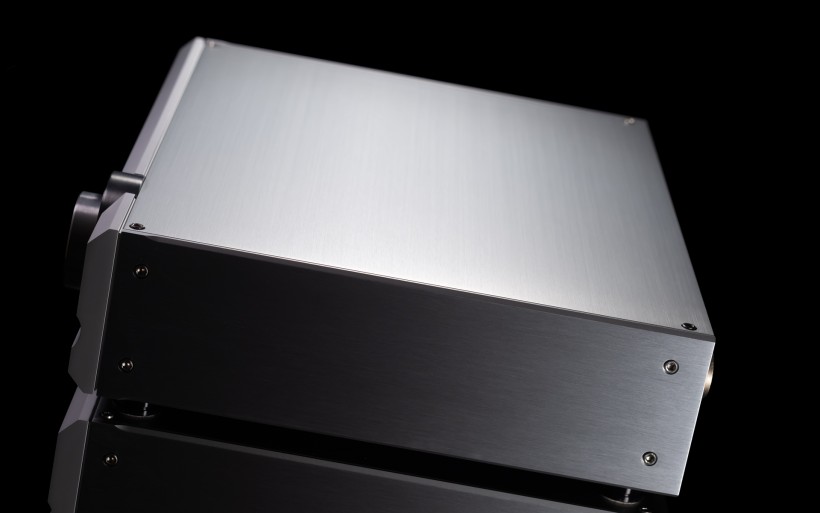 All Pass Labs products sent my way prior to the XP-22 shared quite similar sonic gearing. If I had to encapsulate it in just one word, ‘elegance’ is the best fit I can think of. Here I mean voicing that doesn’t put one specific trait on the pedestal. Instead it packs big tone and fruitiness atop resolution and openness, albeit without the clear bias either towards illumination and spatial grandeur or heft and massive bass. To my ears Pass Labs house sound is roughly in the middle of these trait groups and faced towards the latter. As such it draws from both and blends all ingredients in similar proportions. I consider this meticulously brewed MO as highly universal and typical for well-designed class A devices. It’s also safe. Pass Labs hardware fares brilliantly in well-sorted setups where strong tonal changes to restore the overall balance aren’t needed. This report’s XP-22 follows its siblings on that front, so its role isn’t to fix sound tonally off but elevate what’s already there. It’s also the first Pass that has its voice built upon one predominant trait that serves as the base for all else. I already got a whiff of that aroma during previous Pass assignments. The difference is that the XP-22 has it pronounced so strongly that it can’t be mistaken with anything else.
All Pass Labs products sent my way prior to the XP-22 shared quite similar sonic gearing. If I had to encapsulate it in just one word, ‘elegance’ is the best fit I can think of. Here I mean voicing that doesn’t put one specific trait on the pedestal. Instead it packs big tone and fruitiness atop resolution and openness, albeit without the clear bias either towards illumination and spatial grandeur or heft and massive bass. To my ears Pass Labs house sound is roughly in the middle of these trait groups and faced towards the latter. As such it draws from both and blends all ingredients in similar proportions. I consider this meticulously brewed MO as highly universal and typical for well-designed class A devices. It’s also safe. Pass Labs hardware fares brilliantly in well-sorted setups where strong tonal changes to restore the overall balance aren’t needed. This report’s XP-22 follows its siblings on that front, so its role isn’t to fix sound tonally off but elevate what’s already there. It’s also the first Pass that has its voice built upon one predominant trait that serves as the base for all else. I already got a whiff of that aroma during previous Pass assignments. The difference is that the XP-22 has it pronounced so strongly that it can’t be mistaken with anything else.
When a manufacturer mentions low SNR, I instantly think about high noise rejection manifested via a particular type of audible silence. I’m aware that this may sound counter-intuitive, but bear with me. The more noise is trimmed, the darker the virtual backdrop for all sound sources contained there becomes. When a lot of that gunk is gone, this spatial background morphs into true blackness that separates good products from top shelf performers. This is nothing new. Quite a few audio houses into i.e. cables and isolators already know the drill. My entire setup is packed with accessories designed specifically to keep incoming noise at bay, just so I can fully tap into that spooky canvas and reap all associated benefits. Pass Labs XP-22 granted me access to this realm within seconds into the first audition, as if it wanted to firmly communicate that the above-mentioned seductive darkness was its makers’ top priority.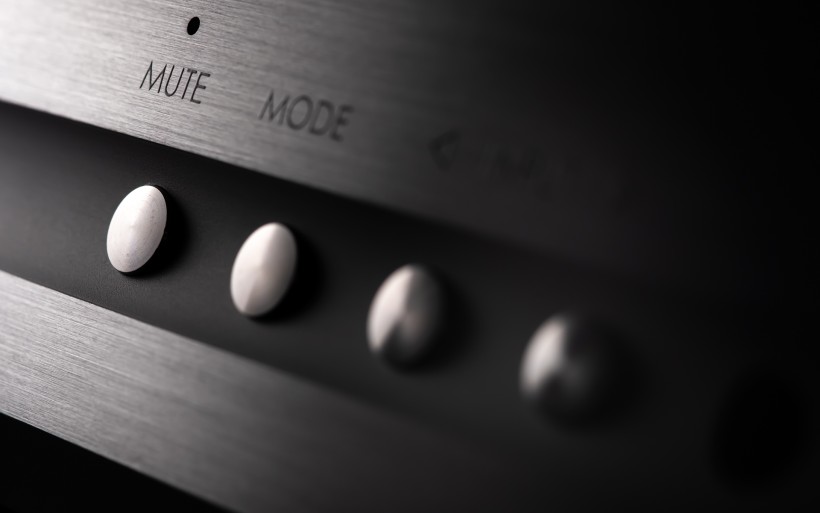 Although the XP-22’s generous dosage of all the extra black ink into sound – or rather its visual representation in my room – wasn’t anything new per se, the sheer potency of this service had me a bit puzzled at first. The manufacturer’s most affordable XP-12 preamp also followed suit in this regard, but that wasn’t mapped as its key virtue. In case of the XP-22 it clearly was. Of course without comparing these machines side by side I can’t know how far apart they really are. However, after sampling both I’m keen to think that Pass Labs’ explanation about incremental improvements from one tier to another is rather conservative. In my system the XP-22 impressed far more. I also know that my brain will remember it as an enjoyably romantic sensual type that knows how and when to bite really hard.
Although the XP-22’s generous dosage of all the extra black ink into sound – or rather its visual representation in my room – wasn’t anything new per se, the sheer potency of this service had me a bit puzzled at first. The manufacturer’s most affordable XP-12 preamp also followed suit in this regard, but that wasn’t mapped as its key virtue. In case of the XP-22 it clearly was. Of course without comparing these machines side by side I can’t know how far apart they really are. However, after sampling both I’m keen to think that Pass Labs’ explanation about incremental improvements from one tier to another is rather conservative. In my system the XP-22 impressed far more. I also know that my brain will remember it as an enjoyably romantic sensual type that knows how and when to bite really hard.
Although the XP-22’s ability to render pristine inky space may read like just one thing, the role of that kind of backdrop is truly extensive. First of all, it’s helpful in keeping quite a few culprits away. The XP-22 doesn’t know how to sound sharp, piercing, garish and overly exposed. Its aesthetic is quite the opposite in fact. Secondly, the Pass’s core voice built upon a silent backbone struck me as completely free from grain, remarkably smooth, not fatiguing at all and truly exquisite. Thirdly, high-tiered noise rejection also plays the enabler for muscle tissue growth, wide color palette, high pigment provision, broad dynamics, quickness and control. The XP-22 has all of that. On gentle vocal/instrumental recordings it sounds sweet, saturated, voluptuous and calm, just to show its ripped, firm, contoured, open and slamming side on heavy metal/rock fare and ambient tracks loaded with low bass pulses. Yes, its charming organic expressive tonally rich personality always shines through, but music on the menu dictates by how much and a listener’s perspective will change accordingly.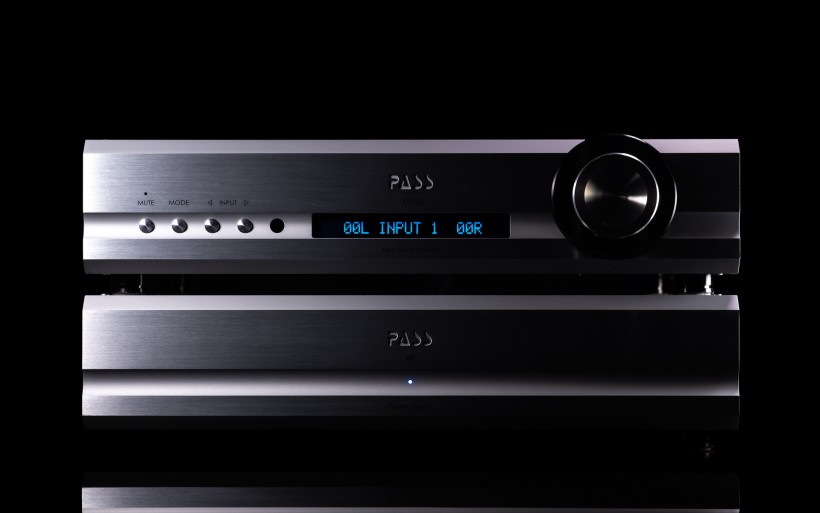 Many untrained ears may not make a connection between the XP-22’s in-built blackness and all the gates it unlocks. Not spicy enough is what some such listeners would say. Audible flashiness and short-term impressiveness aren’t a part of the Pass DNA. Devices with that badge are designed to last their users long time, while their high score on each audible front effectively keeps the upgrade itch at the door. That’s Pass Labs XP-22, too. Although posh from the start, it reveals its sophistication gradually and most definitely doesn’t flaunt any cheap tricks. It’s audibly beefy yet nowhere near slow, wooly, overly round or warm. It’s as intimate, delicate, texturally rich and seductive as it’s packed with nuances, spatially generous in all directions, snappy and accurate. What I really want to say is that this preamp is truly sorted all across the gamut and sonically as brilliant as it’s wholesome. After having lived with it for several weeks all I had was joy. I’m also certain that seasoned enthusiasts with many preamps under their belts will find the XP-22’s artful voice very appealing and mature.
Many untrained ears may not make a connection between the XP-22’s in-built blackness and all the gates it unlocks. Not spicy enough is what some such listeners would say. Audible flashiness and short-term impressiveness aren’t a part of the Pass DNA. Devices with that badge are designed to last their users long time, while their high score on each audible front effectively keeps the upgrade itch at the door. That’s Pass Labs XP-22, too. Although posh from the start, it reveals its sophistication gradually and most definitely doesn’t flaunt any cheap tricks. It’s audibly beefy yet nowhere near slow, wooly, overly round or warm. It’s as intimate, delicate, texturally rich and seductive as it’s packed with nuances, spatially generous in all directions, snappy and accurate. What I really want to say is that this preamp is truly sorted all across the gamut and sonically as brilliant as it’s wholesome. After having lived with it for several weeks all I had was joy. I’m also certain that seasoned enthusiasts with many preamps under their belts will find the XP-22’s artful voice very appealing and mature.
The fight between the XP-22 and Trilogy 915R was interesting to say the least. Prior to moving forward let me stress that the latter was designed to complement Nic Poulson’s 995R monos. It’s a class A design geared for textural moisture, saturation, tactility and elasticity just as the XP-22, but tuned more towards extra openness, dynamic prowess, immediacy, spatial directness, clarity, enormous dynamics, friction and overall impact. To simplify, Trilogy’s reference preamp acts like a coffee shot that keeps 995R mono amps fully awake and alert; speedier, with quicker reaction times and more impactful. The main differences between the 915R and XP-22 weren’t difficult to map at all. The former was spatially a touch larger, more direct, jumpier and tense, so less soothing and relaxed and not quite as intense on color. It also injected more oxygen into generated space, was leaner, more outlined and stiffer downstairs, which resulted in first row closer to the ear, wider dynamic span and higher image pop. Speaking the automotive lingo, Trilogy’s engine was big and supercharged, while the unit inside the Pass was naturally aspirated and packed with two cylinders more. Different measures and driving experiences, roughly similar horsepower. The XP-22’s calm texturally blossomed demeanor went hand in hand with admirable precision, clarity and insight. All these things really can go together, even though the above-mentioned blackness may result in the sensation of sound that’s a bit darkish if not hooded. This is misleading. Clean background doesn’t cover nuances, it’s the other way around. These tiny dust particles are all there, just served casually instead of being showed at one’s ears. That’s exactly how the Pass went about its business. It sounded as if it purposely took its time to carefully condition every transient and note prior to sending it to the amp. It steered my setup’s gestalt towards charm, romance and mood indeed, but I’ve found it as resolved, informative, thunderous and quick as the 915R. The XP-22 simply didn’t communicate its vigor and energy on every occasion. Rather, it released hard powerful contoured stiff jabs on appropriate music, while elsewhere it boasted big tone, roundness, vibrant colors, overall vividness and effortless top end, so traits meant to please not dissect. In other words, the XP-22 proved as accomplished as its opponent on all mandatory fronts and took its own as interesting route from there. More importantly, it firmly held its ground against a far more expensive device well enough to belong to the same very high league.
The XP-22’s calm texturally blossomed demeanor went hand in hand with admirable precision, clarity and insight. All these things really can go together, even though the above-mentioned blackness may result in the sensation of sound that’s a bit darkish if not hooded. This is misleading. Clean background doesn’t cover nuances, it’s the other way around. These tiny dust particles are all there, just served casually instead of being showed at one’s ears. That’s exactly how the Pass went about its business. It sounded as if it purposely took its time to carefully condition every transient and note prior to sending it to the amp. It steered my setup’s gestalt towards charm, romance and mood indeed, but I’ve found it as resolved, informative, thunderous and quick as the 915R. The XP-22 simply didn’t communicate its vigor and energy on every occasion. Rather, it released hard powerful contoured stiff jabs on appropriate music, while elsewhere it boasted big tone, roundness, vibrant colors, overall vividness and effortless top end, so traits meant to please not dissect. In other words, the XP-22 proved as accomplished as its opponent on all mandatory fronts and took its own as interesting route from there. More importantly, it firmly held its ground against a far more expensive device well enough to belong to the same very high league.
Subjectively speaking, Trilogy 995R monos fancied the 915R’s company more, which wasn’t surprising given how synergistic this hardware combination is. The Pass however had its revenge upon changing amps. Enleum AMP-23R is highly energetic, smooth beyond belief, off-charts informative, lucid and also a touch lean. This also is a proper power amp with variable gain, just disguised as an integrated type. It works nicely with external preamps. My DAC with 300B output tubes is one quick direct investigative lean type, too. The XP-22 in-between these two components contributed with the extra heft, color and composure without limiting their core assets comprised of energy, quickness, immediacy and the lot. In other words, in that setup the Pass was a spot on choice that did more than the 915R, which was the final piece of intel to fully grasp how good it truly is. Very.
I still remember how four springs ago Pass Labs XP-12 fared against Kinki Studio EX-P7. That uneven fight ended with the latter carried out inside a body bag. This report’s brawl also wasn’t fair, but its outcome was radically different. The significant price gap between Pass Labs XP-22 and Trilogy 915R didn’t matter at all. As far as sheer sonic excellence goes, I’ve found them equally gifted and packed with just the right set of utilities to keep enthusiasts like myself happy for days. Subjective preferences and individual setup demands will take over from there. And let’s not forget. As brilliantly voiced and plenty posh as Pass Labs XP-22 already is, this twin-box affair is Wayne Colburn’s third be(a)st. There are still two more tiers to go. Now let that sink in…
Associated Equipment:
- Amplifier: Trilogy 995R, FirstWatt F7, Enleum AMP-23R
- DAC: LampizatOr Pacific (KR Audio T-100 / Living Voice 300B + KR Audio 5U4G Ltd. Ed.)
- Speakers: Boenicke Audio W11 SE+, sound|kaos Vox 3afw
- Transport: Innuos Statement, fidata HFAS1-S10U
- Preamplifier: Trilogy 915R, Thöress DFP
- Speaker cables: Boenicke Audio S3, LessLoss C-MARC
- Headphones: HifiMan Susvara
- Speaker signal conditioning: LessLoss Firewall for Loudspeakers, Boenicke ComDev
- Anti-vibration conditioning: 12x Carbide Audio Carbide Bases (under DAC, preamp and speakers)
- Interconnects: LessLoss Entropic Process C-MARC, Boenicke Audio IC3 CG
- Power components: Gigawatt PC-3 SE EVO+/LC-3 EVO, LessLoss C-MARC, LessLoss Entropic Process C-MARC, Boenicke Audio Power Gate, ISOL-8 Prometheus
- USB components: iFi audio Mercury3.0
- Rack: Franc Audio Accesories Wood Block Rack 1+3
- Network: Fidelizer EtherStream, Linksys WRT160N
- Music: NativeDSD
Retail prices of reviewed components in EU (excl. VAT):
- Pass Labs XP-22: $9’975
Manufacturer: Pass Labs






































